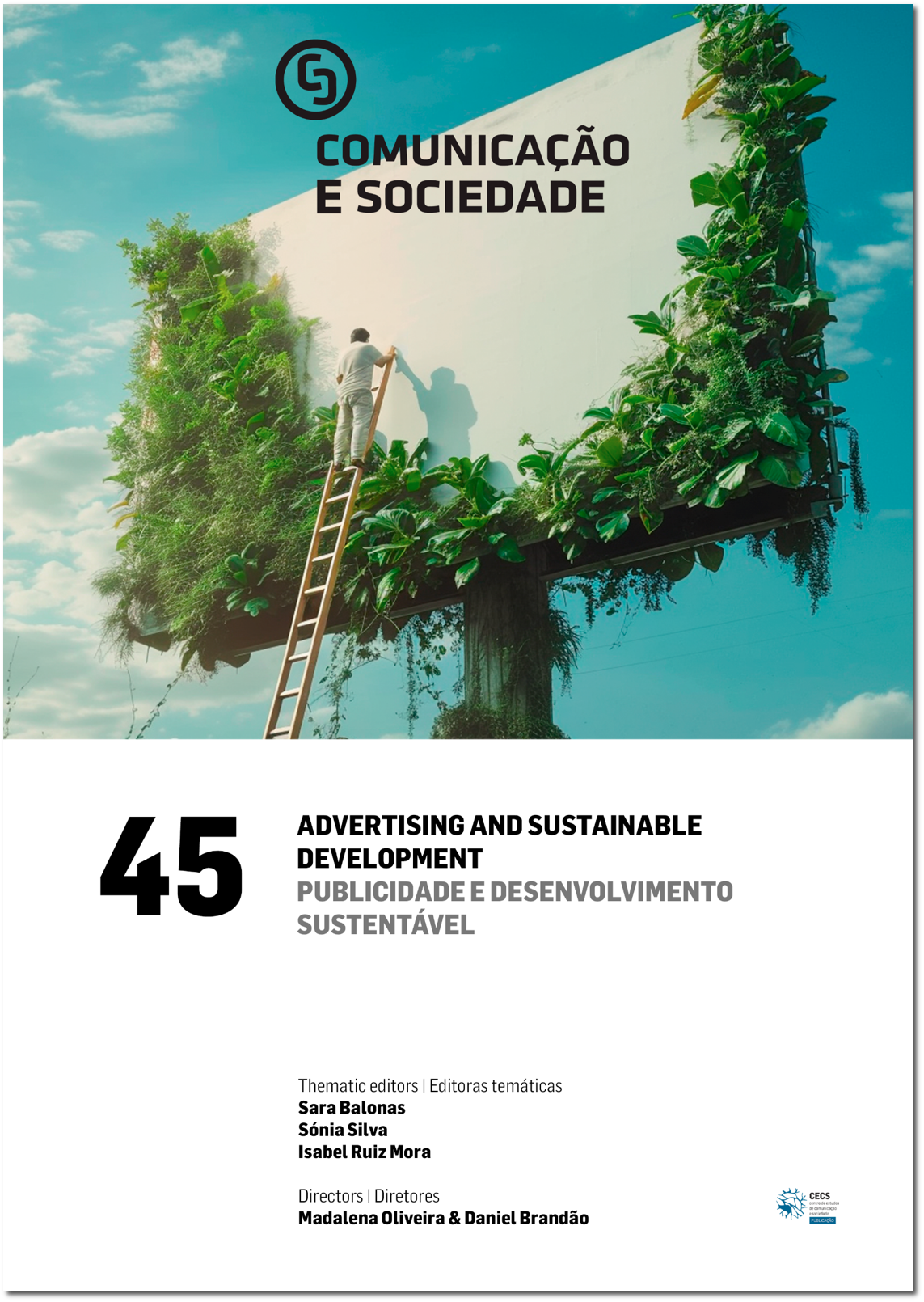Advertising and Sustainability: The Case of “The Last Photo” Campaign
DOI:
https://doi.org/10.17231/comsoc.45(2024).5297Keywords:
symbolic production, sustainability, suicideAbstract
The aim of the research was to investigate the construction of scenes for the socio-environmental campaign that won the most awards at the “Cannes Film Festival” in 2023, in order to identify and describe the media discourses that contribute to the production of culture and values in society. A theoretical-methodological analysis was carried out exploring the interactions between advertising, sustainability and symbolic production, with a focus on evaluating the trajectory of the Cannes awards, which recognise advertising as an agent of social and environmental transformation, identifying campaigns in these areas. The corpus was defined by the most awarded campaign in 2023 at Cannes, related to social and/or environmental issues, in this case “The Last Photo”. The analysis was conducted using a discursive approach, considering lexical elements, argumentative techniques, prominence and components external to verbal language. The results of the study showed that the campaign predominantly uses advertising discourse, especially audiovisual adverts exploring social issues. Scenography plays an important role in the construction of these scenes, lending credibility and emotion to the speeches. The campaign’s approach challenges the stereotypes surrounding suicide, using real cases to promote reflection. Transmedia storytelling and accessible language are used to reach audiences effectively.
Downloads
References
ADAM&EVEDDB. (2023). Exposing the heartbreaking reality of suicide. https://www.ddb.com/creative/01_calmbrand/
Apple. (2022, 30 de novembro). The greatest | Apple [Vídeo]. YouTube. https://www.youtube.com/watch?v=8sX9IEHWRJ8
Barros, L. M (2011). Discursos midiáticos e apropriações culturais. Universidade Metodista de São Paulo.
Boff, L. (2012). Sustentabilidade: O que é, o que não é. Vozes.
Braga, J. L. (2006). A sociedade enfrenta sua mídia: Dispositivos sociais de crítica midiática. Editora Paulus.
Brundtland, H. (1991). Nosso futuro comum. Editora da Fundação Getulio Vargas. (Trabalho original publicado em 1987)
Campaign Against Living Miserably. (2022, 22 de junho). Suicidal doesn’t always look suicidal [Vídeo]. YouTube. https://www.youtube.com/watch?v=6Jihi6JGzjI&rco=1
Carrascoza, J. A. (2004). O apolíneo e o dionisíaco no texto publicitário. Cadernos da Escola de Comunicação, (2), 24–39.
Casaqui, V. (2011). Por uma teoria da publicização: Transformações no processo publicitário. Significação, (36), 131–151.
Conselho de Autorregulamentação Publicitária. (2021/2022). Código brasileiro de autorregulamentação publicitária. http://www.conar.org.br/pdf/codigo-conar-2021_6pv.pdf
Curran, J. (1998). Repensar la comunicación de masas. In J. Curran, D. Morley, & V. Walkerdine (Eds.), Estudios culturales y comunicación (pp. 63–83). Paidós.
Declaração sobre o Direito ao Desenvolvimento, 4 de dezembro de 1986, https://acnudh.org/wp-content/uploads/2012/08/Declara%C3%A7%C3%A3o-sobre-o-Direito-ao-Desenvolvimento.pdf
Design and Art Direction. (s.d.). The postponed day. https://www.dandad.org/awards/professional/2023/237265/the-postponed-day/
Dias, R. (2019). Gestão ambiental: Responsabilidade social e sustentabilidade. Atlas.
‘Dieselgate’: Veja como escândalo da Volkswagen começou e as consequências. (2015, 23 de setembro). G1. https://g1.globo.com/carros/noticia/2015/09/escandalo-da-volkswagen-veja-o-passo-passo-do-caso.html
Eguizábal, R. (2010). Teoría de la publicidad. Catedra.
García Jiménez, J. (2004). Narrativa audiovisual. Cátedra.
García García, F. (2006). Narrativa audiovisual: Televisiva, fílmica, radiofônica, hipermedia y publicitária. Ediciones del Labirinto.
Gaulia, L. A. (2019). Relações públicas, comunicação empresarial, marca e reputação. In L. G. Berlim & P. A. Ashley (Eds.), Ética, responsabilidade social e sustentabilidade nos negócios: (Des)construindo limites e possibilidades (pp. 181–190). Saraiva.
GoAd Media. (2023). Guia Cannes Lions 2023. https://blog.publicidade.uol.com.br/wp-content/uploads/2023/06/GUIA-GOAD_CANNES-LIONS-2023.pdf
Jenkins, H. (2009). Cultura da convergência (S. Alexandria, Trad.). Aleph. (Trabalho original publicado em 2006)
Jenkins, H., Green, J., & Ford, S. (2014). Cultura da conexão: Criando valor e significado por meio da mídia propagável (P. Arnaud, Trad.). Editora Aleph. (Trabalho original publicado em 2013)
Kantar. (2022). Who cares? Who does? https://www.kantar.com/brazil/campaigns/wp/2022/wcwd-latam-2022
Lemos, A. Z. (2023, 4 de julho). Veja as 10 campanhas mais premiadas do mundo no festival de 2023. meio&mensagem. https://www.meioemensagem.com.br/cannes/veja-as-10-campanhas-mais-premiadas-do-mundo-no-festival-de-2023
Lima, G. B. (2012). A publicidade do terceiro setor nas redes sociais digitais: O contrato da comunicação bidirecional [Dissertação de mestrado, Universidade Federal de Pernambuco]. ATTENA.
LLLLITL. (2023, 23 de junho). Fondation Anne de Gaulle - ‘Paris Anne de Gaulle’ (case study) [Vídeo]. YouTube. https://www.youtube.com/watch?v=9GQOAIwGoF8
Lopes, M. I. V. de. (2018a). Jesús Martín-Barbero e os mapas essenciais para compreender a comunicação. Intexto, (43), 14–23. https://doi.org/10.19132/1807-8583201843.14-23
Lopes, M. I. V. de. (2018b). A teoria barberiana da comunicação. MATRIZes, 12(1), 39–63. https://doi.org/10.11606/issn.1982-8160.v12i1p39-63
Maingueneau, D. (2008). Cenas da enunciação (S. Possenti & M. de Souza-e-Silva, Trads.). Parábola Editorial. (Trabalho original publicado em 1998)
Maingueneau, D. (2013). Análise de textos de comunicação (M. de Souza-e-Silva & D. Rocha, Trads.). Cortez. (Trabalho original publicado em 1998)
Marketing & Media. (2023, 23 de junho). WHERE TO SETTLE | Mastercard | McCann Poland [Vídeo]. YouTube. https://www.youtube.com/watch?v=hLKc6waV4xo
Martín-Barbero, J. (2001). Dos meios às mediações: Comunicação, cultura e hegemonia (R. Polido & S. Alcides, Trads.). Editora UFRJ. (Trabalho original publicado em 1987)
Microsoft. (2023, 19 de abril). Can an alphabet preserve a culture? [Vídeo]. YouTube. https://www.youtube.com/watch?v=1GRTS2sFqhY
Miguel, K. G. (2014). Pensar a cibercultura ambientalista: Comunicação, mobilização e as estratégias discursivas do Greenpeace Brasil [Tese de doutoramento, Universidade Metodista de São Paulo]. TEDE.
Mintel. (2023, 31 de outubro). Mintel announces global consumer trends for 2023. https://www.mintel.com/press-centre/mintel-announces-global-consumer-trends-for-2023/
Opinion Box. (2023). Relatório ESG e sustentabilidade 2022: Dados, análises e perspectivas sobre práticas sustentáveis na sociedade e nas empresas brasileiras. https://d335luupugsy2.cloudfront.net/cms%2Ffiles%2F7540%2F1659390488Opinion_box_relatorio_sustentabilidade_ESG_2022_16-9_final_4.pdf
Silva, P. K. (2017). Mídia e produção simbólica: A construção do torcedor-anfitrião no cenário da Copa do Mundo de 2014 no Brasil [Tese de doutoramento, Universidade Metodista de São Paulo]. TEDE.
Souza, K. I. de. (2009). Vídeo digital na educação: Aplicação da narrativa audiovisual na educação [Tese de doutoramento, Universidade Estadual de Campinas].
Vieira, A. (2022, 3 de outubro). Comunicação verde. Meio e Mensagem.
Downloads
Published
How to Cite
Issue
Section
License
Copyright (c) 2024 Priscila Kalinke da Silva, Carlos Henrique Sabino Caldas, Luiz Antonio Feliciano, Rogério Gomes Neto

This work is licensed under a Creative Commons Attribution 4.0 International License.
Authors own the copyright, providing the journal with the right of first publication. The work is licensed under a Creative Commons Attribution 4.0 International License.












